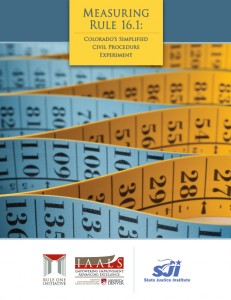New IAALS Study Asks and Answers "What Has Happened with Rule 16.1 in Colorado?"
 IAALS has just released a Rule One Initiative research report entitled Measuring Rule 16.1: Colorado’s Simplified Procedure Experiment. In 2004, the Colorado Supreme Court put in place Rule 16.1, a voluntary pretrial process for smaller dollar-volume civil cases, with the hope of providing a more efficient path to resolution. This new report sets forth the results of an empirical study of Rule 16.1, including its role and impact. With growing interest in streamlined pretrial procedures, case differentiation, and optional processes, we felt it was important to examine one such rule that has existed for some time. Through this study, IAALS attempts to answer the question: What has happened with Rule 16.1 in Colorado?
IAALS has just released a Rule One Initiative research report entitled Measuring Rule 16.1: Colorado’s Simplified Procedure Experiment. In 2004, the Colorado Supreme Court put in place Rule 16.1, a voluntary pretrial process for smaller dollar-volume civil cases, with the hope of providing a more efficient path to resolution. This new report sets forth the results of an empirical study of Rule 16.1, including its role and impact. With growing interest in streamlined pretrial procedures, case differentiation, and optional processes, we felt it was important to examine one such rule that has existed for some time. Through this study, IAALS attempts to answer the question: What has happened with Rule 16.1 in Colorado?
Rule 16.1 is the default pretrial procedure in Colorado district court for typical types of civil actions with less than $100,000 in controversy between any two parties, although any party may "opt out" and elect to use the standard pretrial process instead. This "simplified" procedure generally replaces discovery with mandated disclosures, along with assurances of a faster route to trial. Recovery under Rule 16.1, including attorney fees but excluding costs, cannot exceed the $100,000 limit.
The study documented the highest rate of Rule 16.1 cases in consumer credit collection actions (95%) and other straightforward contract actions in which damages are fixed or liquidated. In 70% of cases proceeding under Rule 16.1, there is no appearance by any defendant, and more than half resolve by entry of default judgment. Overall, the perception among interviewed attorneys and judges is that the cap on damages and inflexible limits on discovery have discouraged attorneys from using the procedure. In other words, given the choice of opting out, many attorneys do just that.
In the 30% of Rule 16.1 cases that were contested and therefore invoked the provisions of the procedure, there is mixed evidence on the rule’s impact. With respect to time to disposition, the county in which the case is filed appears to play a larger role than Rule 16.1. In addition, Rule 16.1 cases have not been shown to have a higher trial rate. However, Rule 16.1 is associated with a decrease in the number of motions filed. It is not possible to know whether the results would have been different if the rule was more frequently applied in actively litigated cases.
Colorado’s experience may contain insight for other jurisdictions as they experiment with formulating sets of rules to more effectively secure the “just, speedy, and inexpensive” resolution of civil cases. Click here to read the full report.


